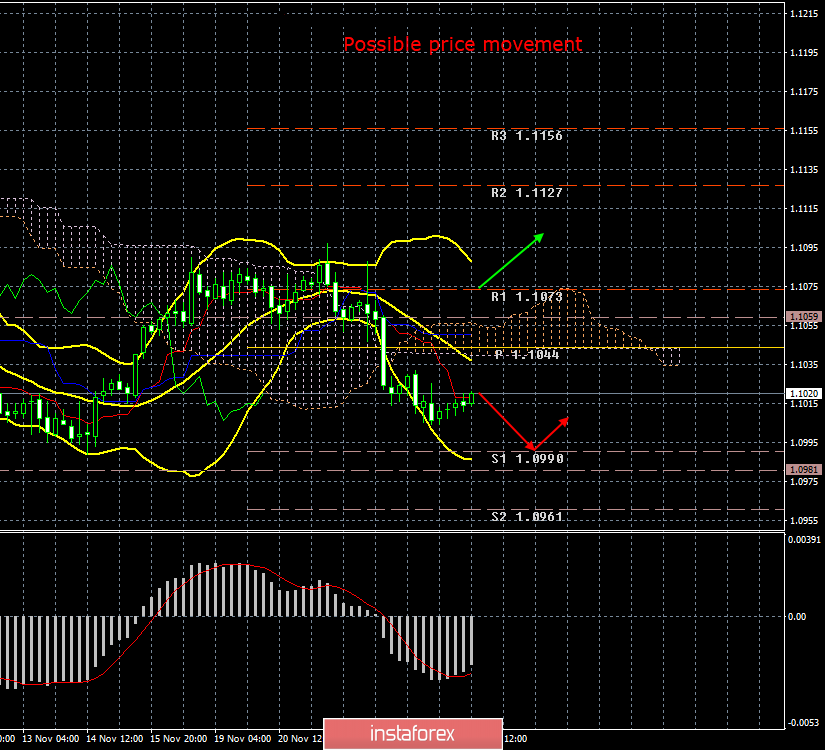4-hour timeframe

Amplitude of the last 5 days (high-low): 21p - 28p - 45p - 74p - 28p.
Average volatility over the past 5 days: 39p (low).
The EUR/USD currency pair continues to trade with low volatility on the second trading day of the week, maintaining a downward trend and correcting against it amid the complete absence of any macroeconomic information. The euro is not like the pound sterling, which stubbornly ignores any statistics and awaits parliamentary elections and decisions on Brexit. On the contrary, the euro is prone to reaction to economic data, only, unfortunately, now no economic data is at the disposal of traders, but the media and periodicals are full of news, so to speak, on near-economic topics and frankly political, which create a common fundamental background, and will also affect the economic performance of the European Union and the United States in the future, therefore they are extremely important.
The first thing to note is the speech of Federal Reserve Chairman Jerome Powell, the first after he was called by Donald Trump. Then (during this meeting) opinions among traders differed. According to official information, Trump called Powell for an "intimate conversation," which he did not forget to mention after the meeting. Some traders were inclined to believe in this version. Another version says that the US president, through the media, was tired of exerting pressure on the Fed chief and urging him to lower key rates as quickly as possible. Be that as it may, we see after Powell's speech today that the conversation with Trump had no effect. The Fed chairman said that the market is still very far from the recession, and even at the current stage of economic development, despite the trade wars, he "sees the glass half full, not empty." According to Powell, interest rates will remain on standby, that is, unchanged in the near future, and the phrase "changing the key rate if the situation requires it" has disappeared from the most common formulations. Thus, we believe that it is definitely not worth expecting a new easing of US monetary policy in the next three to four months. Furthermore, everything will depend on the trade conflict between the United States and China and its escalation/de-escalation. It is not yet clear as to what Trump will do at this point. We have repeatedly said that the US president needs zero rates, and possibly even lower. Most likely, pressure on Powell will resume through the media.
Meanwhile, the Chinese Foreign Ministry on Monday called on US Ambassador Terry Branstad to protest the United States over Congressional approval of the Hong Kong Human Rights and Democracy Act. Official Beijing believes that this position of the US government is a direct intervention in the internal affairs of the country and urged Washington to correct its mistakes and not interfere in the events in Hong Kong. Chinese Deputy Foreign Minister Zheng Zeguang said that Hong Kong is a Chinese city, and all its affairs relate to the internal affairs of China and no state has the right to intervene in them. "The US Congress is openly interfering in the internal affairs of China, flagrantly violating international law and fundamental norms of international relations. The Chinese side expresses deep indignation and declares a protest!", the statement said. Zeguang also warns that "if America does not stop intervening, then all responsibility for the consequences will fall on its shoulders." As you can see, the conflict between the United States and China is heating up. The appeal of the Chinese side is unlikely to be satisfied by the US government. It is not yet clear whether this law will be approved by Trump, whether it will veto it, and whether it will bypass the veto of the Senate, which may well pass this law without Trump's participation. Thus, this story will certainly still be developed. Perhaps the US is using the Hong Kong situation to put additional pressure on Beijing in negotiations on a trade agreement. In this case, again, we can only wait for new information.
From a technical point of view, the situation looks much less confusing than with a fundamental one. The pair is in a downward movement, and at the moment there is a weak correction. After its completion, a resumption of the downward movement is expected with good prospects for updating the two-year lows located around 1.0879.
Trading recommendations:
The EUR/USD pair began a round of correction against the downward trend, and the volatility in trading remains extremely low on Tuesday. Thus, it is now recommended to wait until the correction is completed and sell the euro/dollar pair again with targets at 1.0990 and 1.0981. It is recommended to consider buying the euro no earlier than the reverse consolidation of traders above the critical Kijun-sen line and levels 1.1059 and 1.1073 with the first goal of the resistance level of 1.1127.
Explanation of the illustration:
Ichimoku indicator:
Tenkan-sen is the red line.
Kijun-sen is the blue line.
Senkou Span A - light brown dotted line.
Senkou Span B - light purple dashed line.
Chikou Span - green line.
Bollinger Bands Indicator:
3 yellow lines.
MACD indicator:
Red line and bar graph with white bars in the indicator window.
Support / Resistance Classic Levels:
Red and gray dotted lines with price symbols.
Pivot Level:
Yellow solid line.
Volatility Support / Resistance Levels:
Gray dotted lines without price designations.
Possible price movement options:
Red and green arrows.





















